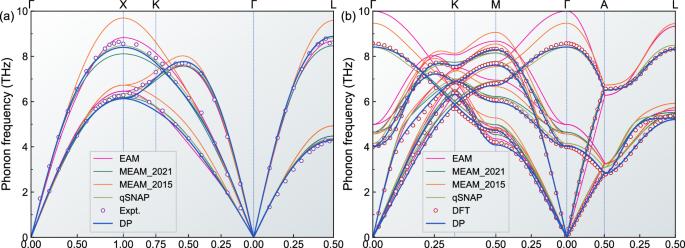镍的精确和可转移的机器学习原子间位势
IF 7.5
Q1 MATERIALS SCIENCE, MULTIDISCIPLINARY
引用次数: 0
摘要
镍(Ni)是一种磁性过渡金属,具有稳定的面心立方(FCC)和易变的六方紧密堆积(HCP)两种各向同性相,广泛应用于结构领域。磁性会影响许多机械和缺陷特性,但自旋极化密度泛函理论(DFT)计算在研究需要大系统规模和/或长模拟时间的材料行为时计算效率低下。在此,我们利用从自旋极化 DFT 计算中获得的训练数据集,为没有磁矩描述符的镍开发了一种 "磁性隐藏 "的机器学习深度势能(DP)模型。DP-Ni 模型在广泛的 FCC 和 HCP 特性(包括(有限温度)晶格参数、弹性常数、声子光谱和许多缺陷)方面表现出卓越的可转移性和可表示性。作为其适用性的一个例子,我们研究了 Ni FCC-HCP 在(高应力)单轴拉伸负载下的各向同性相变。磁性镍的高精度 DP 模型有助于对复杂的相变行为进行精确的大规模原子模拟,并可作为开发镍基超合金和其他多主要成分合金的原子间势能的基础。镍既可以存在于 FCC 相,也可以存在于 HCP 相,是结构应用中的关键金属。本文通过自旋极化 DFT 计算得出了用于镍原子模拟的深度势能,并发现它能准确预测 FCC 和 HCP 相的性质。本文章由计算机程序翻译,如有差异,请以英文原文为准。

An accurate and transferable machine learning interatomic potential for nickel
Nickel (Ni) is a magnetic transition metal with two allotropic phases, stable face-centered cubic (FCC) and metastable hexagonal close-packed (HCP), widely used in structural applications. Magnetism affects many mechanical and defect properties, but spin-polarized density functional theory (DFT) calculations are computationally inefficient for studying material behavior requiring large system sizes and/or long simulation times. Here we develop a “magnetism-hidden” machine-learning Deep Potential (DP) model for Ni without a descriptor for magnetic moments, using training datasets derived from spin-polarized DFT calculations. The DP-Ni model exhibits excellent transferability and representability for a wide-range of FCC and HCP properties, including (finite-temperature) lattice parameters, elastic constants, phonon spectra, and many defects. As an example of its applicability, we investigate the Ni FCC-HCP allotropic phase transition under (high-stress) uniaxial tensile loading. The high accurate DP model for magnetic Ni facilitates accurate large-scale atomistic simulations for complex phase transformation behavior and may serve as a foundation for developing interatomic potentials for Ni-based superalloys and other multi-principal component alloys. Ni can exist in both FCC and HCP phases, and is a key metal for structural applications. Here, a deep potential for atomistic simulations of nickel is derived from spin-polarized DFT calculations, and found to accurately predict the properties of both FCC and HCP phases.
求助全文
通过发布文献求助,成功后即可免费获取论文全文。
去求助
来源期刊

Communications Materials
MATERIALS SCIENCE, MULTIDISCIPLINARY-
CiteScore
12.10
自引率
1.30%
发文量
85
审稿时长
17 weeks
期刊介绍:
Communications Materials, a selective open access journal within Nature Portfolio, is dedicated to publishing top-tier research, reviews, and commentary across all facets of materials science. The journal showcases significant advancements in specialized research areas, encompassing both fundamental and applied studies. Serving as an open access option for materials sciences, Communications Materials applies less stringent criteria for impact and significance compared to Nature-branded journals, including Nature Communications.
 求助内容:
求助内容: 应助结果提醒方式:
应助结果提醒方式:


